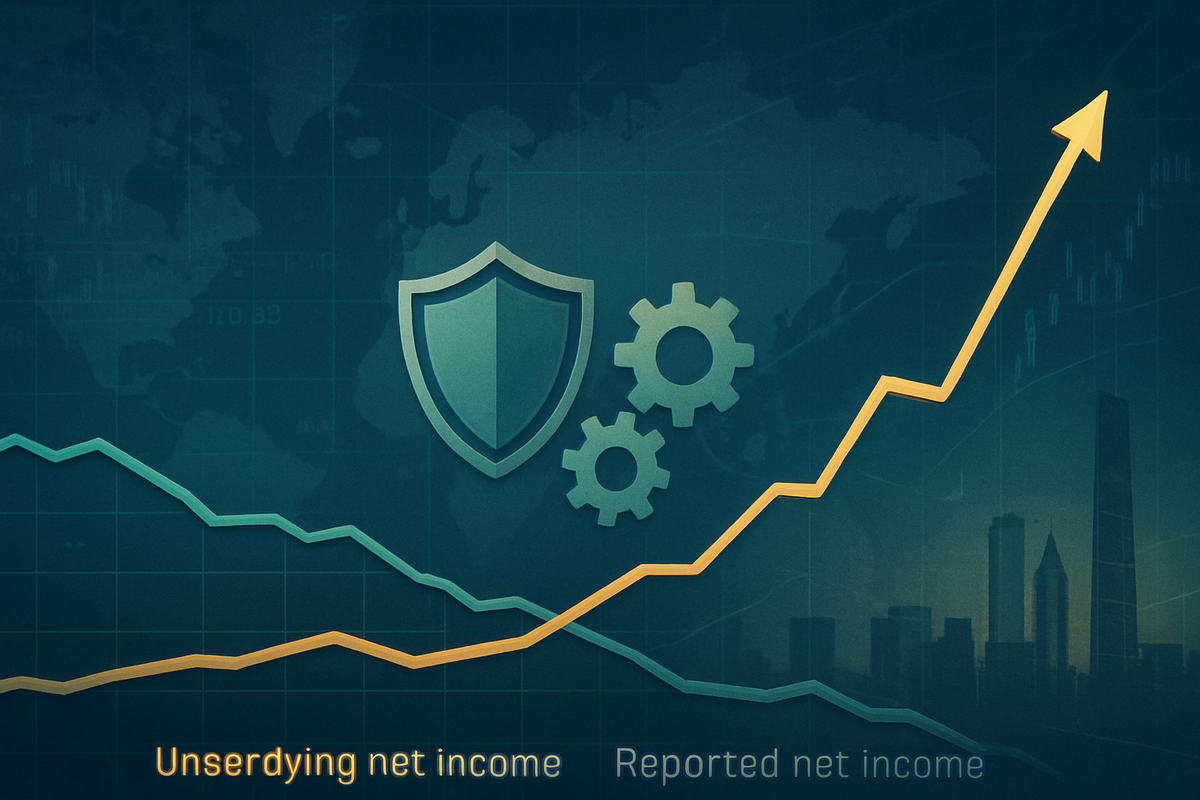
Toronto, Canada – Sun Life Financial Inc. (NYSE: SLF), a global financial services organization, presented a nuanced third-quarter 2023 earnings report that painted a picture of both significant gains and underlying challenges. While the company recorded a robust reported net income of C$871 million, a substantial increase from C$111 million in Q3 2022, investor attention has also been drawn to a modest but notable decline in its underlying net income. This key metric, often favored by analysts for gauging operational performance, registered C$930 million, a 2% decrease from the C$949 million posted in the prior year. This dual narrative suggests that while certain market factors and accounting adjustments boosted overall reported earnings, core operational profitability faced headwinds, prompting a closer examination from the market.
The year-over-year decrease in reported net income suggests potential headwinds impacting Sun Life's core operations and investment performance. While the underlying net income, which excludes certain volatile items, also saw a modest decrease, the more substantial drop in reported net income indicates that factors such as market fluctuations, interest rate changes, or specific operational challenges may have played a more pronounced role. This mixed performance underscores the need for investors to delve beyond headline figures and understand the underlying dynamics shaping the company's financial trajectory.
Unpacking Sun Life's Q3 Performance: Figures, Drivers, and Initial Market Reactions
Sun Life Financial's Q3 2023 financial disclosures revealed a detailed landscape of its recent performance. The reported net income soared to C$871 million, a remarkable turnaround from the C$111 million reported in Q3 2022. This significant uplift was primarily attributed to favorable market-related impacts, largely stemming from interest rates, which helped offset some real estate experience. Additionally, a C$170 million charge related to the sale of Sun Life UK in the prior year (Q3 2022) meant that Q3 2023 benefited from a less impactful charge, further contributing to the reported net income growth.
Conversely, the underlying net income, a measure that strips out certain volatile items to provide a clearer view of operational profitability, experienced a 2% year-over-year dip, settling at C$930 million compared to C$949 million in Q3 2022. This decline was primarily driven by several factors. The "Corporate Expenses & Other" segment saw a substantial increase in net loss, largely due to the sale of Sun Life UK, higher operating expenses (including incentive compensation), and increased debt financing costs. The "Individual - Protection" segment also faced a decline, impacted by the Sun Life UK sale and lower net investment results in the U.S., though business growth in Asia provided some mitigation. Favorable foreign exchange translation offered a slight offset to these declines.
Despite the year-over-year decrease in underlying net income, Sun Life's underlying net income per share of C$1.19 managed to surpass the Zacks Consensus Estimate by 3.4%. This beat on analyst expectations, despite the overall decline in underlying net income, contributed to a generally positive, albeit cautious, initial market reaction. While specific immediate stock price movements on the announcement date (November 13, 2023) are not detailed, analyst commentary around the period indicated a varied sentiment. Some analysts adjusted ratings and price targets, with National Bank Financial reportedly downgrading Sun Life Financial to a "hold" and Scotiabank upgrading it to a "hold," while UBS Group initiated coverage with a "Buy" rating. This diverse analyst perspective highlights the complex interpretation of Sun Life's Q3 results, weighing the operational challenges against the strong reported net income and better-than-expected underlying EPS.
Implications for Sun Life and Its Investors: Navigating Profitability Shifts
The mixed financial results from Sun Life Financial Inc. (NYSE: SLF) in Q3 2023 carry multifaceted implications for the company and its vast investor base. The 2% dip in underlying net income, settling at C$930 million, primarily stems from the strategic sale of Sun Life UK and lower net investment results in its U.S. Individual - Protection segment, alongside elevated corporate expenses, including increased debt financing costs. This operational contraction suggests that while the company is undergoing strategic restructuring, there may be ongoing pressures on its core profitability that management will need to actively address through cost management and optimized asset allocation. Investors, who often view underlying net income as a truer reflection of a company's ongoing business performance, will be scrutinizing future quarters for signs of stabilization and renewed growth in these key operational metrics.
However, the significant surge in reported net income to C$871 million provides a robust counter-narrative, largely driven by favorable market conditions, particularly interest rate movements, and the winding down of prior-year charges associated with the Sun Life UK divestiture. This strong reported performance bolsters Sun Life's capital position, offering a solid foundation for future strategic initiatives and providing a buffer against market volatilities. For investors, this capital strength is crucial, as it underpins the company's ability to maintain and even increase shareholder returns. Indeed, Sun Life demonstrated confidence by increasing its common share dividend from C$0.75 to C$0.78 per share, a clear signal of management's belief in the company's long-term financial health and commitment to returning value to shareholders, even amidst a nuanced earnings report.
The dual nature of the Q3 results also impacts Sun Life's growth strategies and competitive standing. The robust reported earnings provide the financial muscle to pursue strategic investments and partnerships, such as the acquisition of Dialogue, a virtual health provider, increased investment in Bowtie, Hong Kong's first virtual insurer, and a new bancassurance partnership with Dah Sing Bank in Hong Kong. These moves are critical for expanding market reach and adapting to evolving customer needs in key growth regions like Asia. By investing in digital transformation and strategic alliances, Sun Life aims to reinforce its competitive position in an increasingly dynamic global financial landscape, attracting new client segments and enhancing its service offerings. This proactive approach, coupled with a strong financial base, indirectly aids in attracting and retaining top talent, as a company with a clear growth trajectory and financial stability is inherently more appealing to skilled professionals.
Wider Significance: Industry Shifts and Regulatory Crosscurrents
Sun Life Financial's Q3 2023 earnings, particularly the nuanced interplay between its underlying and reported net income, serve as a microcosm of broader trends and challenges reverberating across the global insurance and financial services sector. The adoption of new accounting standards, IFRS 17 Insurance Contracts and IFRS 9 Financial Instruments, effective January 1, 2023, is a significant industry-wide shift. This regulatory change profoundly impacts how insurers measure and present their contracts, leading to the kind of divergence seen in Sun Life's figures and necessitating careful analysis when comparing financial performance across companies and periods. This fundamental reporting change affects all IFRS-compliant insurers, including major Canadian counterparts like Manulife Financial Corporation (TSX:MFC) and Great-West Lifeco Inc. (TSX:GWO), creating a new baseline for financial transparency and comparability.
Beyond accounting shifts, the Q3 period was characterized by persistent inflationary pressures and a high-interest-rate environment, both of which presented mixed blessings for the industry. While higher interest rates generally bolster insurers' investment income over the long term, allowing them to reinvest premiums at better yields, they can also lead to unrealized losses on existing fixed-income portfolios and increase the risk of policyholder surrenders. Sun Life's Wealth & Asset Management segment, for instance, benefited from increased investment income due to higher yields, aligning with this trend. However, inflationary pressures continued to drive up claims costs across the sector, particularly in segments like property and casualty insurance, squeezing underwriting margins for many players. This dynamic underscores the ongoing challenge for insurers to balance investment gains with rising operational and claims expenses.
The emphasis on diversification and strategic growth, evident in Sun Life's acquisitions and partnerships, also reflects a broader industry imperative. With market volatility and economic caution prevailing, financial institutions are increasingly seeking to fortify their business models through varied revenue streams and geographical expansion. Sun Life's strategic investments in virtual health (Dialogue) and virtual insurance (Bowtie in Hong Kong), along with its partnership with The Bank of Nova Scotia (TSX:BNS) for alternative investment distribution, highlight a sector-wide pivot towards digital transformation and specialized offerings. These moves not only enhance customer experience but also enable insurers to tap into new growth markets and adapt to evolving consumer demands, potentially influencing other industry players like iA Financial Corporation Inc. (TSX:IAG) to accelerate their own digital and diversification strategies.
From a regulatory standpoint, Sun Life's performance and the broader industry are operating under increasing scrutiny. The Office of the Superintendent of Financial Institutions Canada (OSFI), the primary federal regulator, introduced and updated several guidelines in 2023, including a new supervisory framework for federally regulated financial institutions (FRFIs) and enhanced guidelines on third-party risk management. These regulatory mandates, alongside growing global calls for greater oversight in Environmental, Social, and Governance (ESG) disclosures and the use of Artificial Intelligence (AI) in financial services, impose additional compliance burdens and shape risk management strategies across the sector. Historically, periods of significant accounting changes or economic uncertainty have often been met with increased regulatory oversight, aiming to ensure stability and consumer protection, a pattern that continues to unfold in the current financial landscape.
What Comes Next: Navigating Future Horizons
Following its Q3 2023 earnings, Sun Life Financial Inc. (NYSE: SLF) is poised to navigate a complex yet opportunity-rich landscape, driven by its strategic focus on diversification, digital innovation, and expansion in key growth markets. In the short term (next 12-18 months), investors can anticipate a continued commitment to shareholder returns, with expectations of further dividend increases and share repurchases, building on the recent hike. The company will likely double down on operational efficiency, leveraging its substantial investments in digital transformation and artificial intelligence to streamline processes, reduce costs, and enhance client satisfaction, particularly through AI-powered customer service. Performance in core segments will be closely watched, with the U.S. dental business showing signs of recovery and plans for repricing dental premiums in 2025 aimed at boosting profitability, while the Canadian market is expected to remain a stable foundation, and Asia continues its robust growth trajectory.
Looking further ahead (3-5+ years), Sun Life's long-term strategy centers on sustained growth, particularly through its strategic expansion in Asia, which is expected to become an even more significant contributor to earnings. The strengthening of its Wealth and Asset Management segment remains a core focus, driven by its higher returns on equity and lower capital requirements, with continued inorganic growth through acquisitions in alternative credit. Digital leadership and innovation are not merely initiatives but are embedded in Sun Life's DNA, with continuous investments in cloud solutions, APIs, and advanced AI, including generative AI, to revolutionize underwriting, claims processing, and customer service. Furthermore, Sun Life's ambitious commitments to sustainability, including net-zero greenhouse gas emissions targets by 2050 and significant sustainable investment goals, align with evolving global expectations and present new avenues for growth and investment.
Sun Life's adaptive strategy includes optimizing its business mix by shifting towards products with lower capital requirements and more predictable earnings, such as voluntary benefits. The company is also enhancing its holistic advice model through platforms like "OnePlan powered by Conquest," empowering advisors to provide comprehensive financial roadmaps to clients. These strategic pivots, coupled with targeted responses to market specifics—like repricing in the U.S. dental market and increasing investments in virtual insurers in Asia—underscore its agility. While opportunities abound in aging populations, wealth accumulation, the burgeoning middle class in Asia, and health and wellness trends, significant challenges persist. Economic volatility, interest rate fluctuations, intense competition, and evolving regulatory scrutiny, including potential impacts from Medicaid funding changes, will require continuous vigilance and robust risk management.
For investors, potential scenarios range from optimistic to pessimistic. An optimistic outlook sees Sun Life effectively leveraging its digital prowess and Asian expansion, coupled with favorable economic conditions, leading to strong growth in assets under management, fee income, and market share, translating into consistent dividend growth and share price appreciation. A base case anticipates steady performance, with its diversified model providing resilience, digital transformation yielding efficiency gains, and Asian expansion progressing as planned, making Sun Life a reliable core holding for long-term, income-oriented investors. Conversely, a pessimistic scenario involving a severe economic downturn, prolonged market volatility, or a sharp decline in interest rates could negatively impact investment income and asset management fees, potentially leading to stagnation or a decline in share price and reduced dividend growth. The company's ability to consistently deliver on its strategic objectives while deftly navigating these market and regulatory complexities will be paramount in shaping its future trajectory.
Comprehensive Wrap-up: Assessing Sun Life's Path Forward
Sun Life Financial Inc.'s (NYSE: SLF) Q3 2023 earnings report delivered a complex, yet strategically revealing, snapshot of its performance. The key takeaway for investors is the crucial distinction between reported net income and underlying net income. While reported net income surged significantly to C$871 million, largely influenced by favorable market conditions and the adoption of new accounting standards (IFRS 17 and IFRS 9), the underlying net income, a clearer indicator of core operational health, saw a modest 2% decrease to C$930 million. This divergence highlights that while market factors can provide a substantial boost to headline figures, sustained operational profitability requires diligent management of expenses and consistent performance across core business segments.
Moving forward, the market is likely to view Sun Life's diversified business mix as a fundamental strength, providing resilience against localized economic headwinds. The robust underlying performance in Wealth & Asset Management and Group - Health & Protection segments, coupled with strategic growth in Asia, positions the company for continued expansion. The increase in the common share dividend further signals management's confidence in the company's long-term financial stability and commitment to shareholder returns. However, challenges such as net outflows from MFS and elevated corporate expenses demand ongoing attention, as they could impact future underlying profitability and investor sentiment. The full implications of the IFRS 17 and IFRS 9 adoption will also continue to unfold, requiring careful analysis when comparing results across periods and with peers.
The lasting impact of Sun Life's Q3 2023 performance will be measured by its ability to effectively integrate recent acquisitions, leverage strategic partnerships, and translate its digital transformation initiatives into sustained underlying net income growth. The company's strategic pivot towards client-centric solutions, including virtual health and digital insurance offerings, is critical for maintaining relevance and market leadership in an evolving financial services landscape. Its strong capital position, reflected in a robust LICAT ratio, reinforces its ability to navigate future economic cycles and support its growth ambitions.
For investors, the coming months will require vigilant monitoring of several key areas. First, continue to focus on underlying net income as the primary gauge of operational performance, carefully differentiating it from reported net income. Watch for the successful integration and performance contributions from strategic acquisitions like Dialogue and the traction gained from the Dah Sing Bank partnership and Bowtie investment in Asia. Pay close attention to asset management flows, especially at MFS, and the overall performance of the U.S. business segment, which faced some headwinds in Q3. Finally, understanding the ongoing impact of the new IFRS accounting standards on financial reporting will be essential for accurate comparative analysis. By keeping these factors in view, investors can gain a more nuanced understanding of Sun Life's trajectory and its potential for long-term value creation.
This content is intended for informational purposes only and is not financial advice





